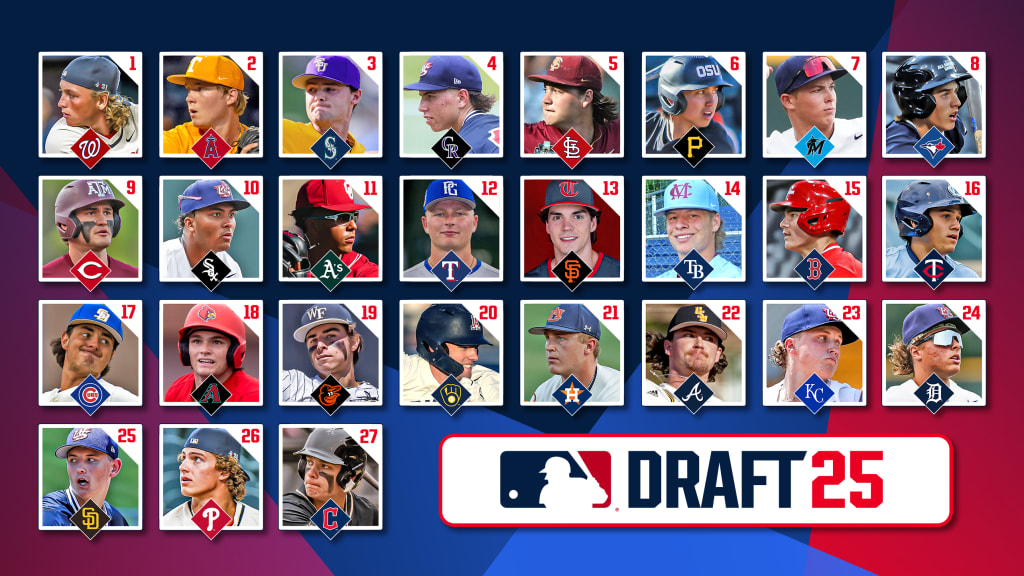
The 2025 Draft class is more volatile than usual, so there's not much certainty with a little more than two months before the Nationals exercise the No. 1 overall pick July 13 during the All-Star Game festivities in Atlanta.
Two high schoolers -- shortstop Ethan Holliday and right-hander Seth Hernandez -- are the consensus top two prospects available, though that doesn't necessarily mean that Washington will select either. Holliday struggled on the showcase circuit last summer and no prep righty ever has gone No. 1. They're still the favorites, but the Nationals are believed to be casting a wide net that also includes college left-handers Jamie Arnold, Kade Anderson and Liam Doyle, college shortstop Aiva Arquette, high school shortstop Eli Willits and perhaps others.
2025 MLB Draft presented by Nike
Day 1 (Rounds 1-3): Pick-by-pick analysis | Top storylines
Day 2 (Rounds 4-20): Round-by-round analysis
- Tracker | Bonus tracker | Top 250 prospects
- Best hauls | Biggest steals
- Pipeline Podcast analyzes Draft
- Picks with famous relatives | Quickest to the bigs
- Corona HS makes Draft history
- Complete coverage
More on the top picks:
1. WSH: Willits | 2. LAA: Bremner | 3. SEA: Anderson | 4. TEX: Holliday | 5. STL: Doyle
6. PIT: Hernandez | 7. MIA: Arquette | 8. TOR: Parker | 9. CIN: Hall | 10. CWS: Carlson
Prep infielders are by far the greatest strength of this Draft and our initial projection of 2025 features eight coming off the board with the top 15 choices and 10 total among the 27 first-rounders. The Mets, Yankees and Dodgers all had their top pick bumped down 10 places into the supplemental first round because they exceeded the second surcharge threshold of the competitive balance tax.
Detailed scouting reports, grades and video for players below can be found with MLB Pipeline's Draft Top 150 list.
1. Nationals: Ethan Holliday, SS/3B, Stillwater (Okla.) HS (No. 1)
This pick probably comes down to Holliday vs. Hernandez in the end, and the Nationals wouldn't be as skittish about taking a high school righty 1-1 as other teams would. Ethan would become the second Holliday family member to go No. 1 in the last four Drafts, following brother Jackson, and has a physical build more reminiscent of their father Matt, a seven-time All-Star. He generates huge power with an easy left-handed stroke and profiles best defensively as a solid third baseman.
2. Angels: Liam Doyle, LHP, Tennessee (No. 10)
Whomever the Angels take here will be a favorite to be the first player from this Draft to reach the big leagues. They've been linked mostly to the top trio of college left-handers and Doyle in particular. He has led NCAA Division I in strikeouts for most of the spring, thanks to a mid-90s explosive fastball, though there are some concerns about his heater-heavy approach and unorthodox delivery. If the Angels opt for a bat, it would be Arquette.
3. Mariners: Kade Anderson, LHP, Louisiana State (No. 9)
The Mariners would strongly consider Hernandez but one of the college southpaws seems more plausible. The best college sophomore available, Anderson has a more traditional delivery than Doyle and a quality four-pitch mix that has him challenging for the D-I strikeout lead in his first season as a weekend starter.
4. Rockies: Seth Hernandez, RHP, Corona (Calif.) HS (No. 2)
Would the Rockies opt for a prep righty this high after first-round misses on Mike Nikorak and Riley Pint in the previous decade? Perhaps not, but he may be the most talented player in the Draft with a fastball that reaches triple digits, a highly advanced changeup, a pair of high-spin breaking balls and plenty of athleticism, polish and projection. If the Nationals don't take Holliday, he probably gets to Colorado and this looks like his floor.
5. Cardinals: Jamie Arnold, LHP, Florida State (No. 3)
Unless Holliday somehow dropped to the Cardinals, they'd likely be looking at the college lefties. Arnold has a longer track record of dominance than Doyle or Anderson, not to mention plenty of action on a mid-90s fastball and low-80s slider and a history of strikes.
6. Pirates: Aiva Arquette, SS, Oregon State (No. 5)
The best college position player available, Arquette has more power upside than most middle infielders and still will profile well offensively even if he slides over to second base. He could fit into the top three picks and this is probably as low as he would go.
More from MLB Pipeline:
• Top 100 prospects | Stats | Video | Podcast | Complete coverage
7. Marlins: Eli Willits, SS, Fort Cobb-Broxton HS, Fort Cobb, Okla. (No. 4)
The son of former big league outfielder Reggie Willits, Eli is the most well-rounded of the deep pool of high school shortstops -- and he might be the most well-rounded player in the whole Draft.
8. Blue Jays: Billy Carlson, SS, Corona (Calif.) HS (No. 6)
This would make Hernandez and Carlson the highest-selected prep teammates in the same Draft, surpassing the 2007 Chatsworth (Calif.) HS duo of Mike Moustakas (No. 2) and Matthew Dominguez (No. 12). Some evaluators think Carlson is the best defensive high school shortstop they've ever seen, though he may require a swing upgrade that may not be hard to implement.
9. Reds: Jace LaViolette, OF, Texas A&M (No. 7)
LaViolette entered the year No. 2 on our original Top 100, but he has had an up-and-down spring that included going 1-for-12 with six strikeouts against Louisiana State last weekend in front of a large group of scouts. While he offers the best combination of power, physicality and athleticism in the Draft, his swing-and-miss issues concern clubs.
10. White Sox: Kayson Cunningham, SS/2B, Johnson HS, San Antonio (No. 15)
The White Sox could start a run on the second tier of high school shortstops that also includes Steele Hall, JoJo Parker and Daniel Pierce. Cunningham was as good as any hitter on the showcase circuit last summer and gives off some José Ramírez vibes, albeit with less pop.
11. Athletics: Kyson Witherspoon, RHP, Oklahoma (No. 8)
The lone right-hander among the top tier of college pitchers, Witherspoon can get swings and misses with four different pitches (mid-90s fastball, upper-80s cutter, mid-80s slider, low-80s curveball) and could go higher than this.
12. Rangers: JoJo Parker, SS, Purvis (Miss.) HS (No. 14)
Parker has the highest offensive ceiling among the second tier of prep shortstops, though he's also the least likely to remain an up-the-middle defender.
13. Giants: Steele Hall, SS, Hewitt-Trussville HS, Trussville, Ala. (No. 13)
Hall is the fastest early-round prospect in the Draft and also the best defender among the Cunningham/Parker/Hall/Pierce group.
14. Rays: Daniel Pierce, SS, Mill Creek HS, Hoschton, Ga. (No. 18)
Pierce continues to climb boards with his combination of four solid-or-better tools (everything but power) and high baseball IQ.
15. Red Sox: Gavin Fien, 3B, Great Oak HS, Temecula, Calif. (No. 29)
Though Fien hasn't had a dominant spring, teams haven't forgotten that he ranked alongside Cunningham as the best bats on the showcase circuit and still buy into his offensive upside.
16. Twins: Luke Stevenson, C, North Carolina (No. 19)
While Stevenson has batted just .282 in two seasons with the Tar Heels, his combination of power, receiving skills and arm strength make him unquestionably the best of a shallow pool of catchers in this Draft.
17. Cubs: Tyler Bremner, RHP, UC Santa Barbara (No. 17)
Bremner joined Arnold atop the college pitching crop before an inconsistent first two months to his season, but he's starting to rally with four double-digit strikeout outings in his last five starts. He owns the most wicked changeup in this class.
18. Diamondbacks: Gavin Kilen, 2B, Tennessee (No. 16)
The consensus best pure hitter in the college class, Kilen is slashing .378/.469/.733 with nearly as many homers (11) as strikeouts (14).
19. Orioles: Marek Houston, SS, Wake Forest (No. 12)
This is on the low end for Houston, a consensus top-10 pick before an April slump who remains one of the best defensive shortstops in college baseball.
20. Brewers: Brendan Summerhill, OF, Arizona (No. 22)
Summerhill didn't help his cause by breaking his right hand punching a water cooler in March, but he still has a sweet lefty swing and the upside of a 20-20 center fielder.
21. Astros: Ike Irish, OF/C, Auburn (No. 20)
Irish can make a case for having the best combination of hitting ability, power and plate discipline among college hitters. As a result, teams would rather have him maximize his offense as a right fielder than try to make him a catcher.
22. Braves: J.B. Middleton, RHP, Southern Mississippi (No. 31)
The most underrated college starter in the Draft is Middleton, a 6-foot righty who pitches for a mid-major but can show three plus pitches and provide plenty of strikes. He owns the best ERA (1.86) among all Draft-eligible arms in NCAA D-I.
23. Royals: Josh Hammond, 3B, Wesleyan Christian Academy, High Point, N.C. (No. 40)
Hammond entered the year more highly regarded as a pitching prospect but wants to play every day and has hit his way toward the first round. He fits the third-base profile well with at least plus raw power and well above-average arm strength.
24. Tigers: Slater de Brun, OF, Summit HS, Bend, Ore. (No. 25)
As a smaller, lefty-hitting sparkplug from the Pacific Northwest, de Brun has a lot of similarities to Corbin Carroll at the same stage of their careers.
25. Padres: Kruz Schoolcraft, LHP, Sunset HS, Portland, Ore. (No. 11)
Along with Willits and Hall, Schoolcraft projects to go in the first round after reclassifying from the 2026 Draft. He's huge (6-foot-8) and athletic, and he's a lefty who can hit 98 mph with his fastball and spin a two-plane slider up to 88.
26. Phillies: Xavier Neyens, 3B, Mount Vernon (Wash.) HS (No. 26)
Neyens' left-handed power rivals that of Holliday, though he comes with more questions about his bat.
27. Guardians: Ethan Conrad, OF, Wake Forest (No. 27)
Shades of 2022 Guardians first-rounder Chase DeLauter? Conrad made a successful jump from Marist to Wake Forest and showed the possibility of solid tools across the board before hurting his left shoulder diving for a ball in March, necessitating season-ending surgery.
